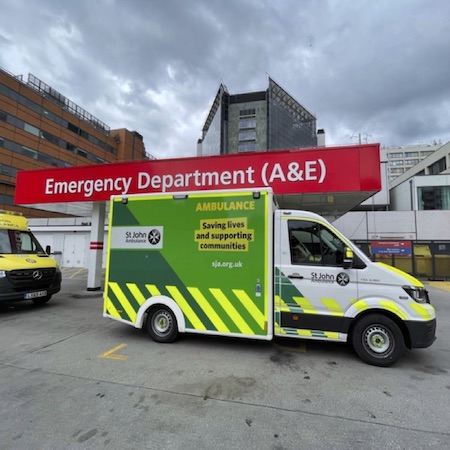St John Ambulance has been formally commissioned to provide England’s ambulance auxiliary, following a competitive tendering process. The first aid and health response charity will continue adding resilience to NHS ambulance Trusts, treating and transporting patients across the country, through a contract worth up to £30 million over four years.
Richard Lee, St John Ambulance’s Deputy Chief Executive and Chief Operating Officer, says: “St John has always supported the health service through emergency ambulance provision during peak periods and seasonal demands, but this new contract gives the vital relationship between our charity and NHS England firm foundations for the future.
“This evolution of our long-standing relationship with the health service enables us to put in the additional long-term planning and investment in people and fleet that’s required to live up to our mission of being an ambulance auxiliary that can be relied upon every time.”
The ambulance auxiliary contract, which starts immediately, will see St John Ambulance provide at least 5,000 hours per month of support (more than 400 12-hour shifts) to England’s 10 NHS ambulance Trusts. St John provided support for ambulance services throughout the pandemic and has been called upon by the NHS during periods of winter pressures and other emergencies before that. The charity has around 800 ambulance crew members - a mixture of employees and volunteers - with more than 250 ambulances.
Professor Sir Stephen Powis, NHS National Medical Director, says: “Hardworking NHS colleagues across the country have gone over and above this summer, despite significant pressures, including the recent heatwave along with the busiest ever June for 999 calls and record numbers of the most urgent ambulance call outs for services.
“The new Ambulance Auxiliary Service helps to build on the vital role played by St John Ambulance since the formation of the health service and will complement existing services, with the support of around 800 emergency ambulance crew members and 250 ambulances.
“This new agreement with one of our longest partners is a welcome addition as the NHS does everything it can to boost capacity ahead of what is set to be another difficult winter.”
A&E waits continue
Whilst boosting the ambulance service is a positive move, especially for patients enduring a long wait for an ambulance to arrive, it only addresses one part of the problem Trusts are facing as we head towards autumn and winter pressures loom.
Just last week, ITV’s Tonight programme revealed the extent of the problem in long waits at A&E departments, which have negatively-impacted the patient’s recovery, and resulted in an “unacceptable” level of stress for ambulance workers.
The show, ‘999: A National Emergency?’, saw Paul Brand given access to the NHS frontline, joining paramedics on blue light call outs and hearing how they work long shifts and battle excessive waits outside hospital A&Es. Data revealed in a survey conducted by GMB Union and commissioned by ITV revealed that one third of ambulance workers have been involved with cases where a patient’s death was linked to delay and 85% have witnessed delays which have seriously affected a patient’s recovery. 82% of ambulance workers feel the current pressure puts them at an unacceptable level of stress and 72% have considered leaving the service.
The latest figures (June 2022) from NHS England show the number of patients waiting more than four hours from the decision to admit to admission increased to 130,109 in June and those waiting more than 12 hours increased to 22,034. These figures are down from March 2022 (136,298 and 22,506 respectively) but up from May 2022 (122,768 and 19,053 respectively). Emergency services remain under high levels of pressure, with 2.18 million A&E attendances making it the busiest ever June for emergency departments.
The figures also show NHS staff continue to face challenges discharging patients into community and social care setting - more than half of patients fit for discharge in June remained in hospital - an average of 11,590 patients each day.
HSJ has today published analysis of data from 20 of England’s largest Trusts, which reports 12-hour waits in A&E departments from the time of arrival until discharge, admission or transfer, and reveals the true scale of A&E delays and overcrowding in emergency departments is even higher. (Article is paywalled).
Last month (July), Dr Katherine Henderson, President of the Royal College of Emergency Medicine, called for this data to be published by NHS England and urged the new Secretary of State for Health and Social Care, Steve Barclay to recognise the severity of the crisis and make tackling it his top priority.
“In the short term, the Health Secretary must recognise how important it is for 12-hour data measured from time of arrival (and already collected by all NHS Trusts in England) to be published by NHS England (as promised). This will allow for transparency of data and help us see the true scale of the crisis and begin to tackle it,” says Dr Henderson.
“Secondly, good social care underpins an effective health service and well-functioning emergency care system. It is vital that social care has adequate resources and staff, who are valued and respected. Good social care will help patients be discharged from hospital in a timely way rather than staying longer than medically necessary. The government must deliver a meaningful plan for social care, that includes a fair pair agreement that values social care workers’ vital role.
“Lastly, the Health Secretary must finally commit to publishing the fully-funded workforce plan that this government promised to deliver. This would address the huge shortfall in staff across the health service, and in turn allow the system to open more staffed beds.”









